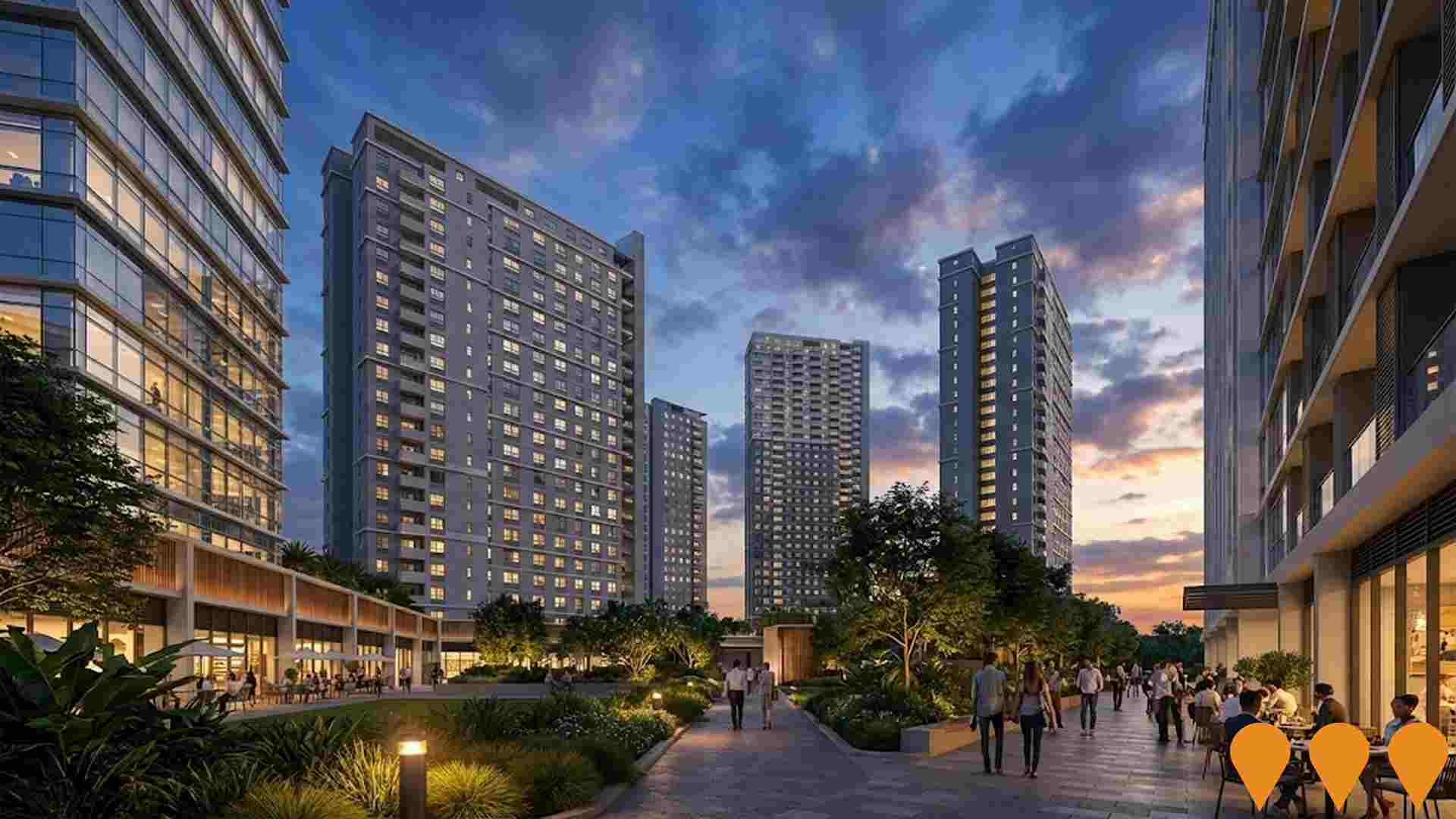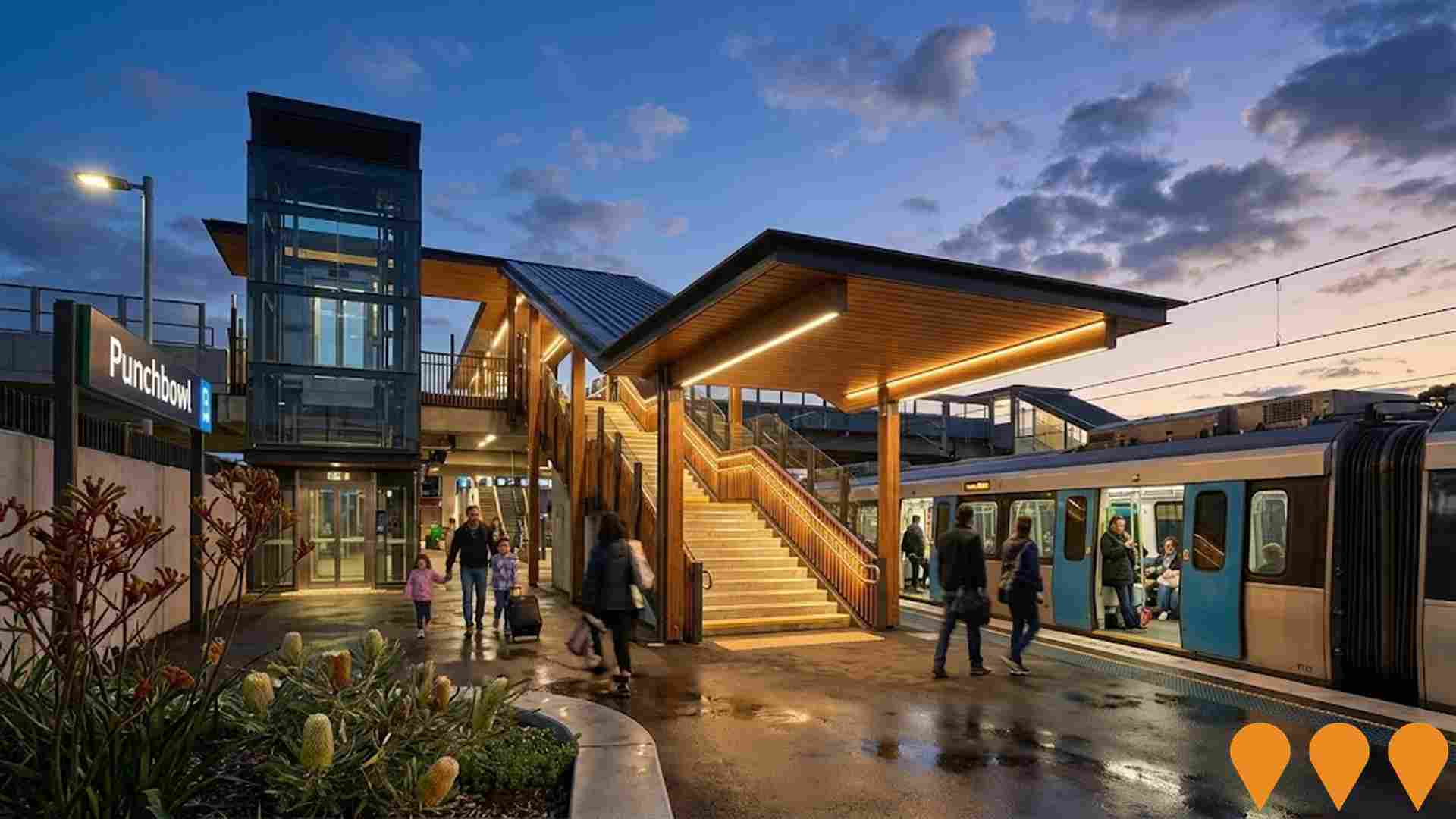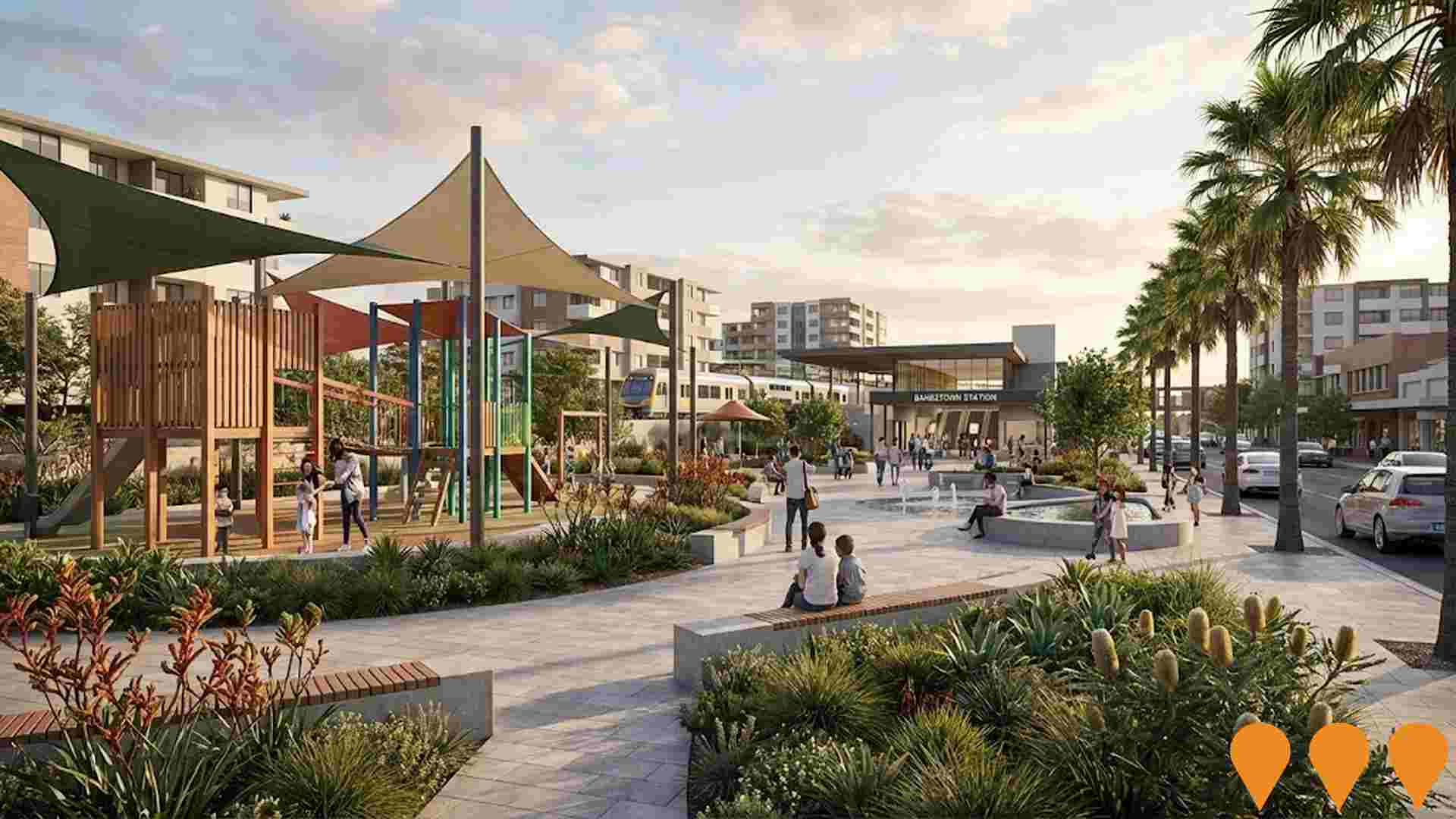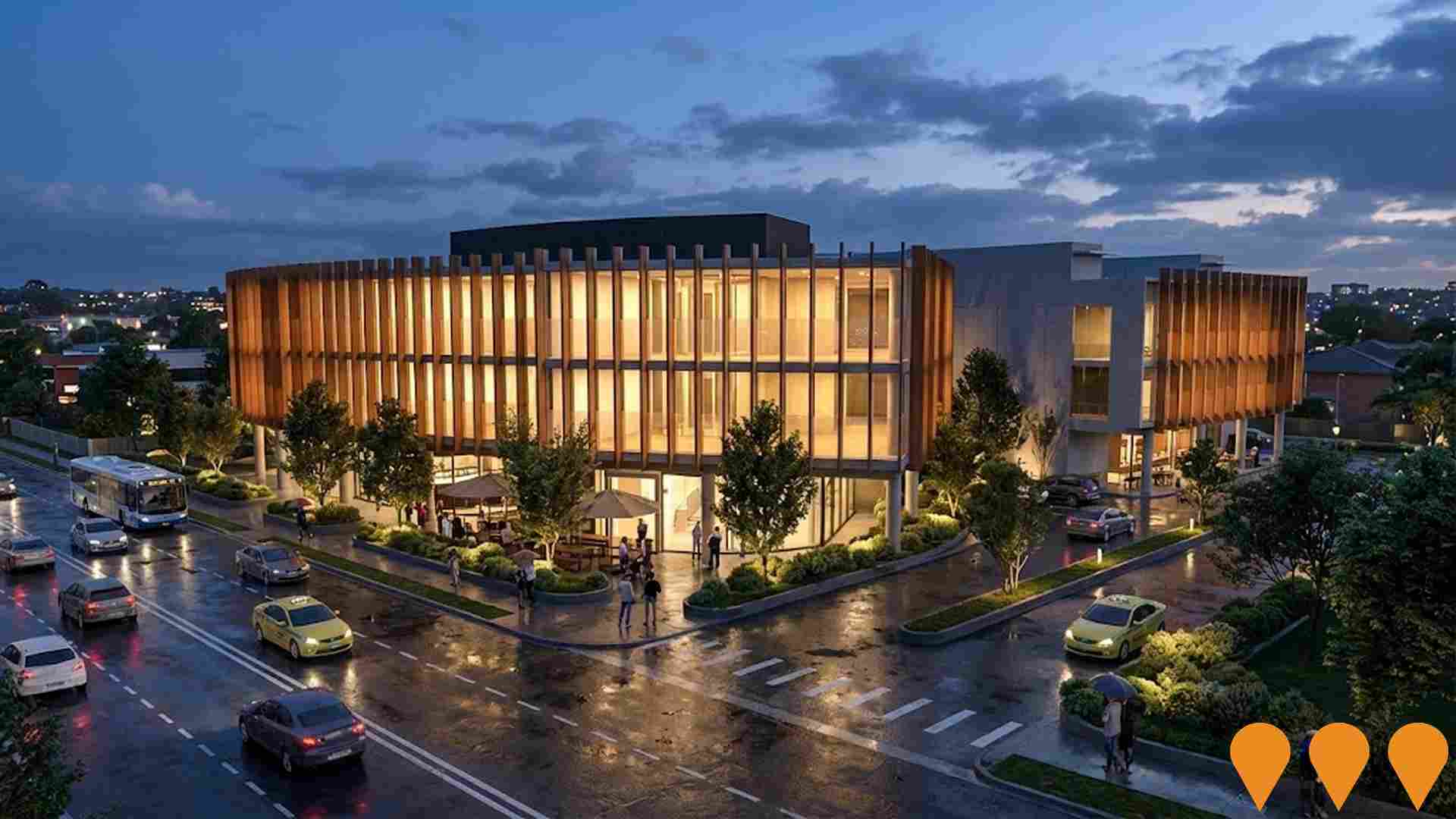Chart Color Schemes
est. as @ -- *
ABS ERP | -- people | --
2021 Census | -- people
Sales Activity
Curious about local property values? Filter the chart to assess the volume and appreciation (including resales) trends and regional comparisons, or scroll to the map below view this information at an individual property level.
Find a Recent Sale
Sales Detail
Population
Bankstown - South lies within the top quartile of areas nationally for population growth performance according to AreaSearch analysis of recent, and medium to long-term trends
Bankstown - South's population is approximately 19,134 as of August 2025. This figure represents an increase of 700 people since the 2021 Census, which recorded a population of 18,434. The increase is inferred from the estimated resident population of 19,137 in June 2024 and an additional 64 validated new addresses since the Census date. This results in a population density ratio of 4,329 persons per square kilometer, placing Bankstown - South among the top 10% of locations assessed by AreaSearch. Over the past decade, Bankstown - South has shown resilient growth patterns with a compound annual growth rate of 1.5%, outperforming the SA3 area. Overseas migration contributed approximately 71.9% of overall population gains during recent periods.
AreaSearch uses ABS/Geoscience Australia projections for each SA2 area, released in 2024 with a base year of 2022. For areas not covered by this data, AreaSearch utilises NSW State Government's SA2 level projections, released in 2022 with a base year of 2021. Growth rates by age group from these aggregations are applied to all areas for years 2032 to 2041. Based on projected demographic shifts, Bankstown - South is forecasted to experience significant population growth, increasing by 7,701 persons to reach a total of 26,835 by 2041, indicating a gain of 40.3% over the 17-year period.
Frequently Asked Questions - Population
Development
AreaSearch assessment of residential development activity positions Bankstown - South among the top 25% of areas assessed nationwide
Bankstown - South saw approximately 73 new homes approved annually. From FY21 to FY25368 homes were approved, with 11 more approved in FY26 by June. Each year, around 3.5 new residents arrived per dwelling constructed during these years.
This lagging supply may intensify buyer competition and pricing pressures. New properties are constructed at an average value of $398,000, below the regional average, offering affordable housing options. In FY26, $54.1 million in commercial approvals have been registered, indicating strong commercial development momentum. Compared to Greater Sydney, Bankstown - South has about three-quarters the building activity per person and ranks at the 62nd percentile nationally for areas assessed.
New building activity comprises 31.0% detached houses and 69.0% townhouses or apartments. This skew towards compact living provides affordable entry pathways, attracting downsizers, investors, and first-time purchasers. Bankstown - South has around 469 people per dwelling approval, reflecting an established area. By 2041, the location is expected to grow by 7,704 residents. If current construction levels persist, housing supply may lag population growth, potentially intensifying buyer competition and supporting price growth.
Frequently Asked Questions - Development
Infrastructure
Bankstown - South has strong levels of nearby infrastructure activity, ranking in the top 30% nationally
Changes in local infrastructure significantly affect an area's performance. AreaSearch has identified 29 projects that could impact the region. Notable initiatives include Bankstown Exchange (Stage 1 - Bankstown Central Masterplan), Appian Way and North Terrace Drainage Upgrades, New Bankstown Hospital, and Bankstown CBD Transformation. The following list details those most likely to be relevant.
Professional plan users can use the search below to filter and access additional projects.
INFRASTRUCTURE SEARCH
 Denotes AI-based impression for illustrative purposes only, not to be taken as definitive under any circumstances. Please follow links and conduct other investigations from the project's source for actual imagery. Developers and project owners wishing us to use original imagery please Contact Us and we will do so.
Denotes AI-based impression for illustrative purposes only, not to be taken as definitive under any circumstances. Please follow links and conduct other investigations from the project's source for actual imagery. Developers and project owners wishing us to use original imagery please Contact Us and we will do so.
Frequently Asked Questions - Infrastructure
Bankstown TOD Accelerated Precinct
State-led Transport Oriented Development (TOD) Accelerated Precinct around Bankstown station and CBD. Rezoning effective 27 November 2024 delivering capacity for 14,000 new homes (including 3-4% affordable housing) and 14,300 new jobs across a large mixed-use precinct. Features buildings ranging from 1 to 25 storeys around the new Metro station. Includes new parks, improved transport connectivity, walkways and cycleways. Part of the NSW Government's TOD Program to boost housing supply near major transport hubs. The NSW Government has committed $520 million to provide active transport links and quality public open spaces across TOD Accelerated Precincts. Potential upgrades proposed for Memorial Park and Griffith Park. Development expected over the next 10-15 years.
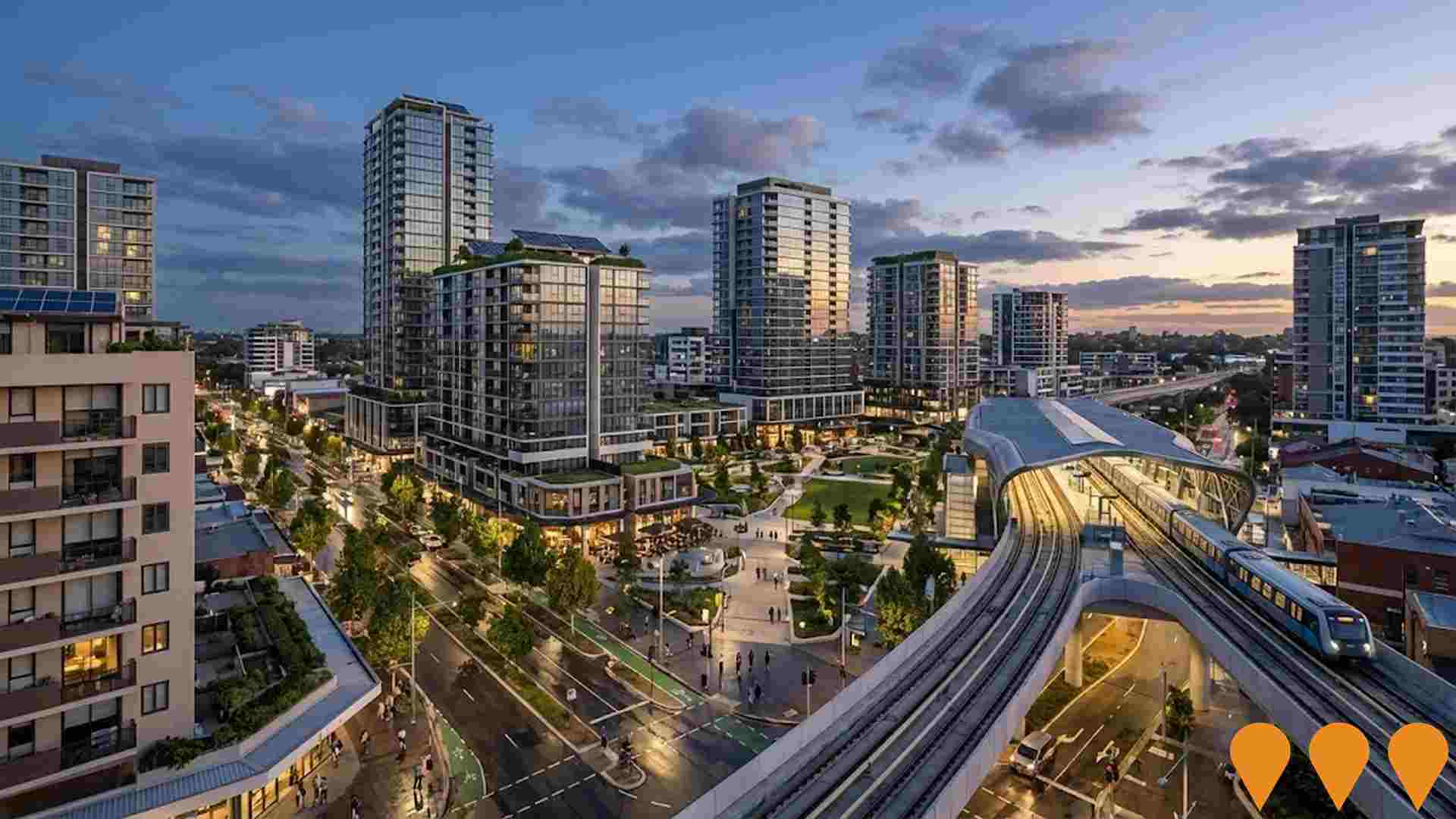
New Bankstown Hospital
The NSW Government is delivering a brand-new $2 billion+ state-of-the-art hospital on the Bankstown TAFE campus site in the Bankstown CBD. This is the largest single investment in a public hospital in NSW history. The new multi-storey facility will deliver expanded emergency, intensive care, operating theatres, maternity, paediatrics, mental health, cancer care, aged care and comprehensive teaching/training facilities. The existing Bankstown-Lidcombe Hospital will transition acute services to the new site upon completion (expected 2031) and be repurposed for community health services. As of December 2025 the project remains in detailed planning with the State Significant Development Application (SSD-46059944) under assessment by the Department of Planning, Housing and Infrastructure. Community consultation continues and early works (site preparation and demolition) are scheduled to commence in 2026 subject to final approvals.
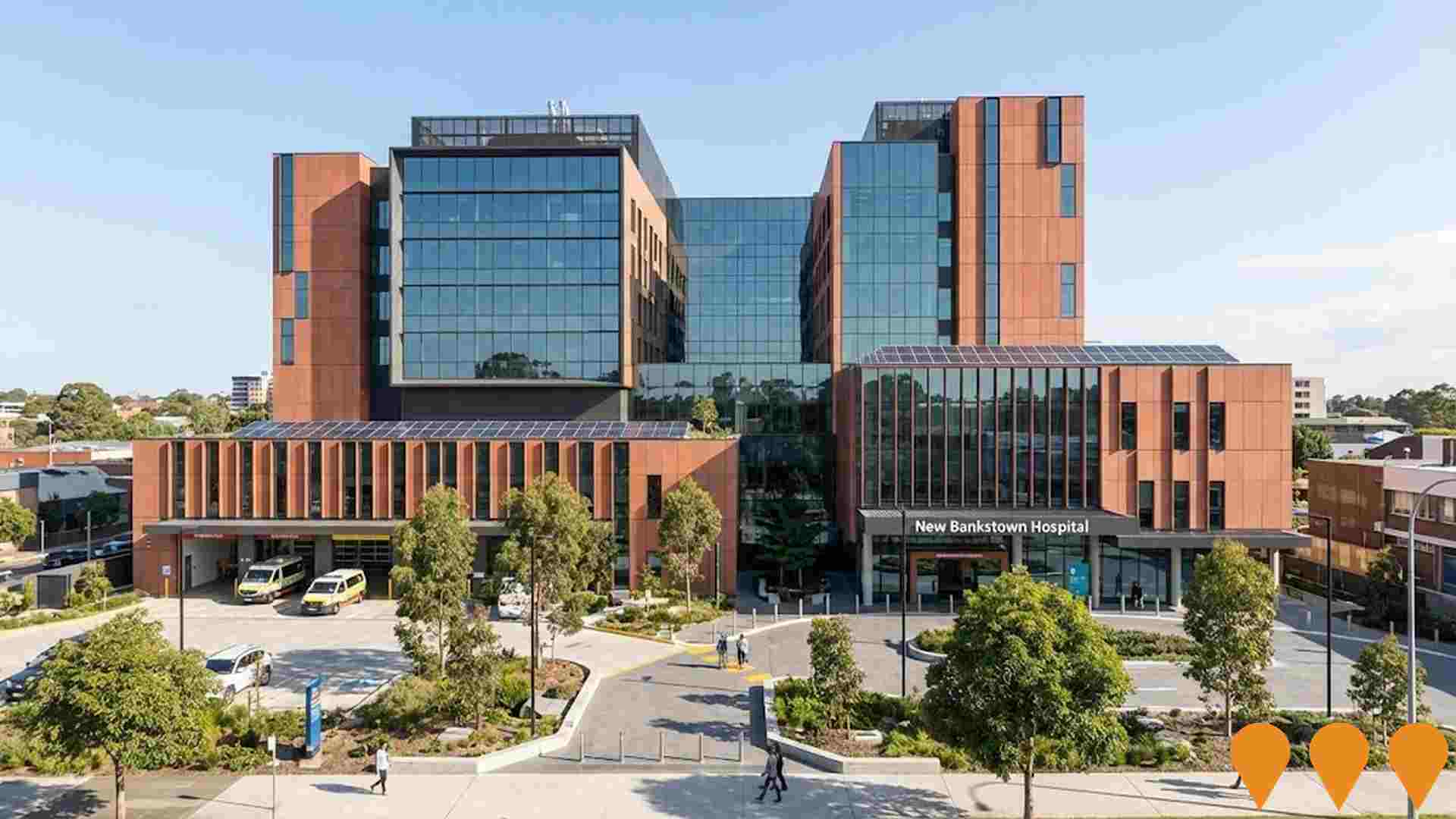
Bankstown CBD Transformation
The comprehensive transformation of the Bankstown CBD is underway. Key components include the Bankstown CBD Upgrade (in construction) and the adoption of the Bankstown City Centre Master Plan (Planning Proposal submitted for Gateway Determination). The Master Plan guides streetscape improvements, new mixed-use developments, enhanced public spaces, and transport connectivity to create a vibrant, walkable city center, celebrating cultural diversity and supporting future growth. Recent completed projects under this umbrella include a $27 million stormwater upgrade, Paul Keating Park Play Space, and The Appian Way Pedestrian Mall transformation. The overall vision is a long-term, multi-developer initiative for Bankstown to become a leading health, education, and jobs hub.

Sydney Metro Bankstown Line Conversion
Conversion of the T3 Bankstown Line between Sydenham and Bankstown to metro standards as part of the Sydney Metro City & Southwest project. Includes upgrades to 11 stations with platform screen doors, new signalling systems, accessibility enhancements (lifts and level access), track modifications, and introduction of autonomous, air-conditioned metro trains with 4-minute peak frequencies. The line closed in September 2024 for intensive conversion works managed by Martinus Rail. Expected to open in 2026 (delayed from earlier targets due to industrial action). Provides fast travel times, e.g., Bankstown to Central in 28 minutes, and forms part of the overall 66 km Sydney Metro network.
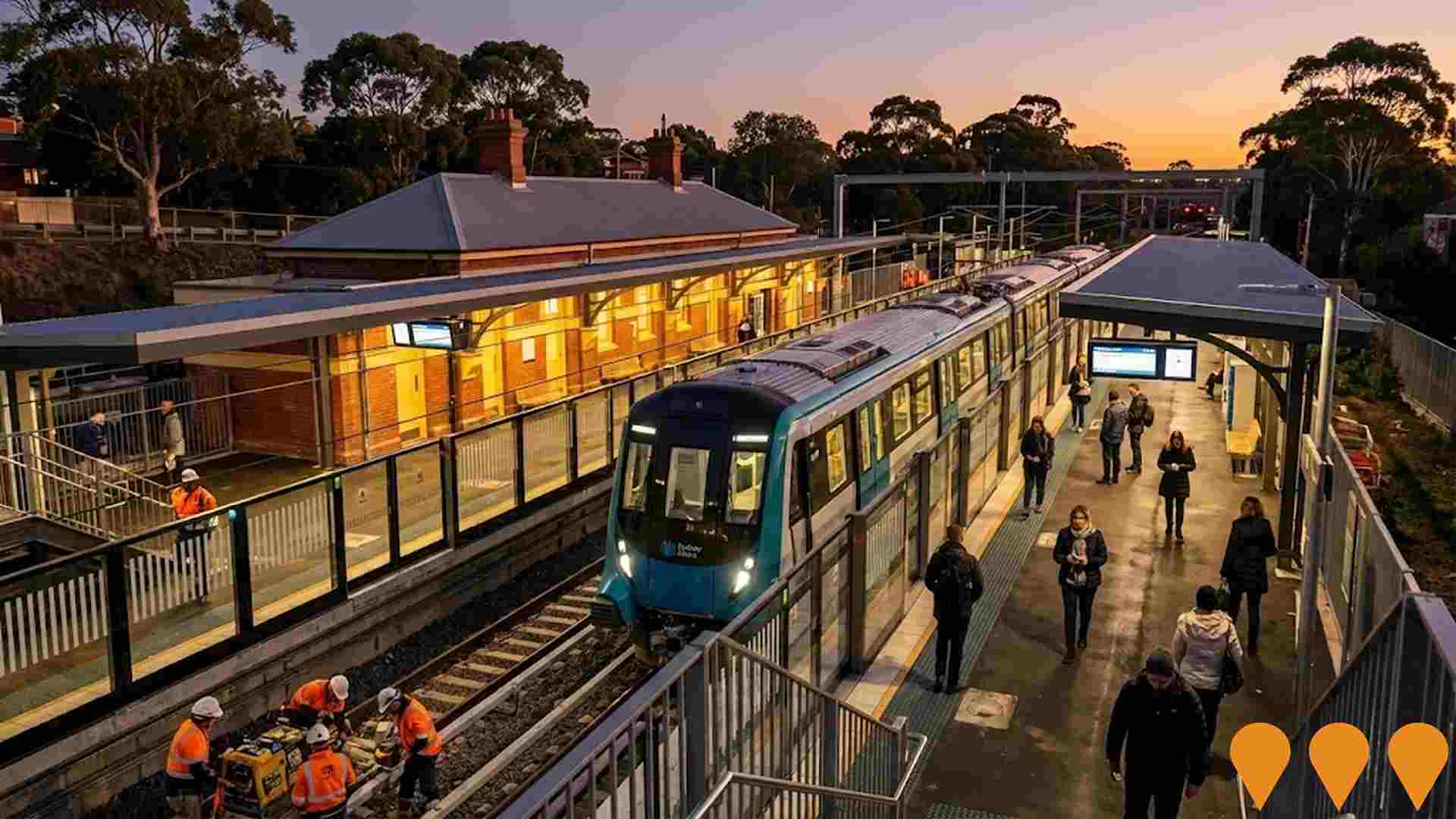
Community Infrastructure Strategic Plan 2050
Canterbury-Bankstown Council's adopted long-term framework (2023-2050) guiding the planning, funding and delivery of community infrastructure including libraries, community centres, aquatic and leisure facilities, sports fields, parks, cultural spaces and civic facilities to support a growing and changing population across the entire LGA.

Bankstown Central Masterplan
A 30-year transformational redevelopment of 11.4 hectares in Bankstown CBD into a vibrant mixed-use urban neighbourhood. Stage One, Bankstown Exchange, features 30,000 sqm of A-grade commercial office space across three buildings with ground-floor retail and an Eat Street dining precinct. The full masterplan includes up to 3,500 residential apartments, 1,800 student accommodation units, 800-guest hotel, serviced apartments, childcare facilities, and landscaped green spaces. The project aims to create a Health and Education Innovation Precinct, supporting 8,400 workers and generating significant economic activity. Retail precinct upgrades include The Grand Market fresh food area with new Coles supermarket, plus major retailers like Uniqlo, JB Hi-Fi, and Services Australia. The development integrates with the Sydney Metro City & Southwest line and complements the adjacent Western Sydney University campus.
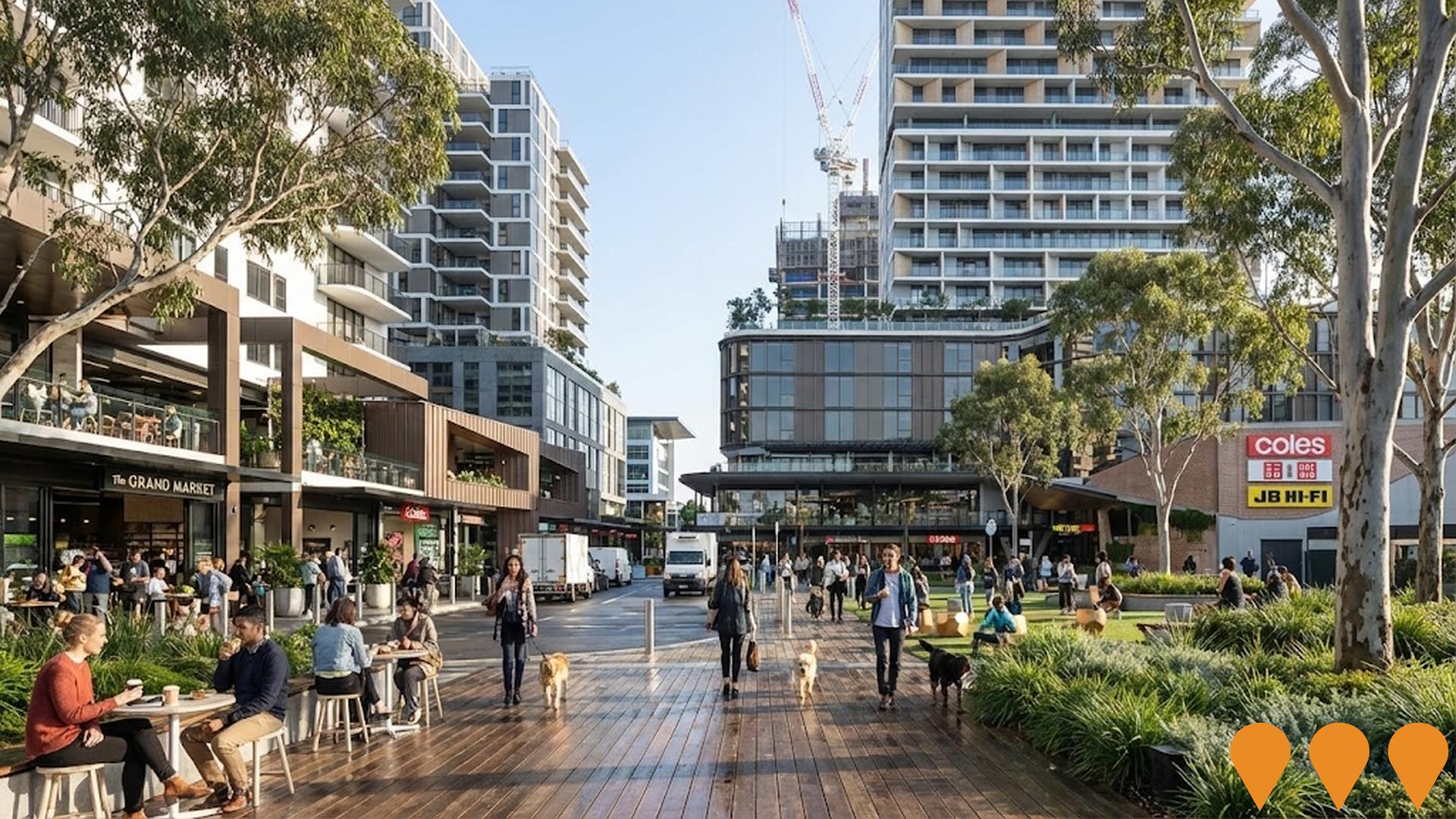
Bankstown Exchange (Stage 1 - Bankstown Central Masterplan)
Stage 1 of the Bankstown Central masterplan delivers approximately 30,000 sqm of A-grade commercial office space across three buildings (two 8-level towers and one 5-level building), ground-floor retail with an activated 'Eat Street' dining precinct, new public plazas, a repositioned bus interchange, basement parking for 320 vehicles, 240 bicycle spaces and end-of-trip facilities. The project is a key catalyst for the Bankstown Health and Education Innovation Precinct.
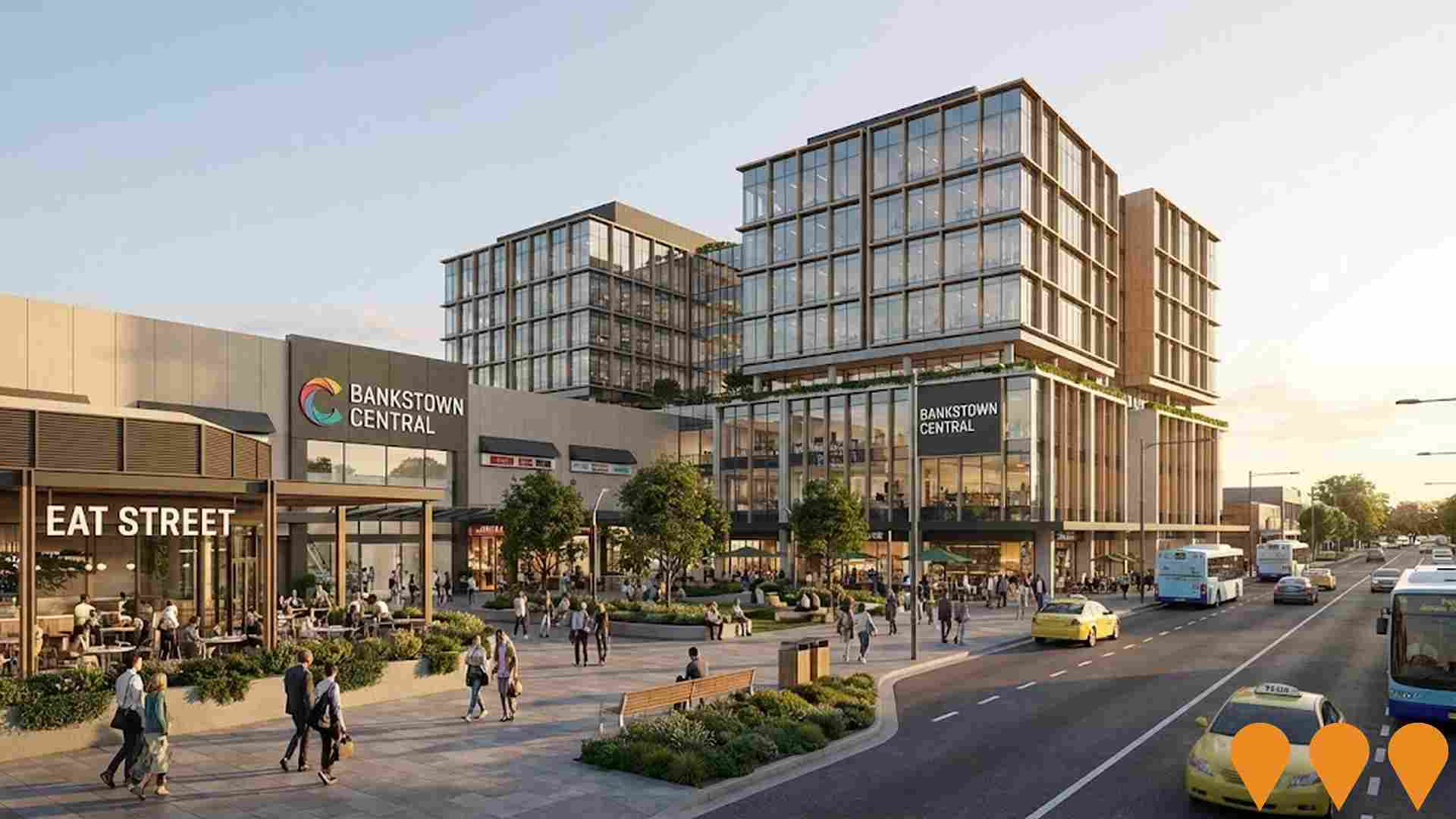
Compass Centre Redevelopment
Redevelopment of the Compass Centre site in Bankstown with demolition of existing structures and construction of a mixed-use precinct featuring a 5-storey podium and three towers: one 19-storey hotel (~169 rooms) and two 24-storey residential build-to-rent towers (339 apartments). Includes retail spaces, supermarket, gym, childcare centre, medical centre, function centre, through-site links to Bankstown Station and Paul Keating Park, enhanced public domain, landscaping, and a two-level basement. SSD application (PPSSDH-182) under assessment as of November 2025.

Employment
AreaSearch assessment indicates Bankstown - South faces employment challenges relative to the majority of Australian markets
Bankstown - South has an educated workforce with diverse sector representation. Its unemployment rate was 8.5% in June 2025, compared to Greater Sydney's 4.2%.
Employment growth over the past year was estimated at 2.0%. As of June 2025, 8,587 residents were employed, with a workforce participation rate of 44.9%, significantly lower than Greater Sydney's 60.0%. Key employment sectors include health care & social assistance, retail trade, and manufacturing. Manufacturing is particularly strong, with an employment share 1.7 times the regional level.
However, professional & technical services are under-represented at 7.0% compared to Greater Sydney's 11.5%. Many residents commute elsewhere for work. Between June 2024 and June 2025, employment levels increased by 2.0%, while the labour force grew by 2.5%, causing unemployment to rise by 0.5 percentage points. In contrast, Greater Sydney saw employment growth of 2.6% and an unemployment rate increase of 0.3 percentage points. National employment forecasts from Jobs and Skills Australia (May 2025) project a 6.6% expansion over five years and 13.7% over ten years. Applying these projections to Bankstown - South's employment mix suggests local growth of approximately 6.2% over five years and 13.2% over ten years.
Frequently Asked Questions - Employment
Income
The area's income levels rank in the lower 15% nationally based on AreaSearch comparative data
AreaSearch's latest postcode level ATO data for financial year ending June 2022 shows median income in Bankstown - South was $39,796 and average income was $49,900. This contrasts with Greater Sydney's median income of $56,994 and average income of $80,856 in the same period. Based on Wage Price Index growth rate of 12.61% from financial year ending June 2022 to September 2025, estimated median income for Bankstown - South would be approximately $44,814 and average income would be around $56,192 by September 2025. According to the Census conducted in August 2021, household income ranks at the 24th percentile ($1,355 weekly) and personal income is at the 5th percentile. The earnings profile indicates that 31.2% of locals (5,969 people) predominantly earn between $1,500 - 2,999 per week, reflecting regional patterns where 30.9% fall within this range. Housing affordability pressures are severe with only 76.7% of income remaining, ranking at the 17th percentile.
Frequently Asked Questions - Income
Housing
Bankstown - South features a more urban dwelling mix with significant apartment living, with a higher proportion of rental properties than the broader region
Bankstown - South's dwelling structure, as per the latest Census, consisted of 36.2% houses and 63.8% other dwellings (semi-detached, apartments, 'other' dwellings). This contrasts with Sydney metro's 61.5% houses and 38.4% other dwellings. Home ownership in Bankstown - South was at 24.3%, with mortgaged dwellings at 24.9% and rented ones at 50.8%. The median monthly mortgage repayment was $1,820, lower than Sydney metro's average of $2,240. Weekly rent in Bankstown - South was $415, compared to Sydney metro's $425. Nationally, Bankstown - South's mortgage repayments were below the Australian average of $1,863, while rents were substantially higher than the national figure of $375.
Frequently Asked Questions - Housing
Household Composition
Bankstown - South features high concentrations of group households, with a lower-than-average median household size
Family households account for 74.3% of all households, consisting of 37.3% couples with children, 18.4% couples without children, and 16.4% single parent families. Non-family households make up the remaining 25.7%, with lone person households at 21.1% and group households comprising 4.6% of the total. The median household size is 3.0 people, which is smaller than the Greater Sydney average of 3.1.
Frequently Asked Questions - Households
Local Schools & Education
Educational outcomes in Bankstown - South fall within the lower quartile nationally, indicating opportunities for improvement in qualification attainment
Bankstown - South has a university degree holders rate of 28.3% among residents aged 15+, compared to Greater Sydney's 38.0%. Bachelor degrees are the most common (19.9%), followed by postgraduate qualifications (7.2%) and graduate diplomas (1.2%). Vocational pathways account for 24.1%, with advanced diplomas at 10.6% and certificates at 13.5%. Educational participation is high, with 35.3% of residents currently enrolled in formal education: 10.0% in primary, 8.4% in secondary, and 7.8% in tertiary education.
The area has seven schools educating approximately 3,171 students, operating under typical Australian school conditions (ICSEA: 968). These include three primary, two secondary, and two K-12 schools.
Frequently Asked Questions - Education
Schools Detail
Nearby Services & Amenities
Transport
Transport servicing is high compared to other areas nationally based on assessment of service frequency, route connectivity and accessibility
Bankstown - South has 90 active public transport stops. These are a mix of train and bus stations. They are served by 48 individual routes which together provide 13,107 weekly passenger trips.
Transport accessibility is excellent with residents typically located 141 meters from the nearest stop. Service frequency averages 1,872 trips per day across all routes, equating to approximately 145 weekly trips per individual stop.
Frequently Asked Questions - Transport
Transport Stops Detail
Health
Bankstown - South's residents boast exceedingly positive health performance metrics with younger cohorts in particular seeing very low prevalence of common health conditions
Health outcomes data shows excellent results in Bankstown - South, with younger cohorts having particularly low prevalence of common health conditions. Private health cover rate stands at approximately 46%, covering about 8,820 people, compared to Greater Sydney's 48.6% and the national average of 55.3%. Diabetes and arthritis are the most prevalent medical conditions, affecting 5.3% and 5.0% of residents respectively.
About 79.4% of residents report no medical ailments, higher than Greater Sydney's 75.8%. Bankstown - South has 14.7% of residents aged 65 and over (2,806 people), lower than Greater Sydney's 15.8%. Health outcomes among seniors require more attention despite being above average.
Frequently Asked Questions - Health
Cultural Diversity
Bankstown - South is among the most culturally diverse areas in the country based on AreaSearch assessment of a range of language and cultural background related metrics
Bankstown-South is one of the most culturally diverse areas in Australia, with 61.1% of its population born overseas and 81.1% speaking a language other than English at home. The primary religion in Bankstown-South is Christianity, which accounts for 35.1% of the population. Notably, Buddhism is overrepresented at 13.9%, significantly higher than the Greater Sydney average of 6.7%.
Regarding ancestry, the top three groups are 'Other' at 24.7%, Vietnamese at 22.3% (substantially higher than the regional average of 8.5%), and Lebanese at 12.4%. Other ethnic groups with notable divergences include Macedonian at 2.1% (vs regional 1.7%), Greek at 3.1% (vs regional 3.4%), and Samoan at 0.7% (vs regional 0.5%).
Frequently Asked Questions - Diversity
Age
Bankstown - South hosts a young demographic, positioning it in the bottom quartile nationwide
Bankstown-South's median age is 34 years, lower than Greater Sydney's average of 37 and Australia's 38 years. Compared to Greater Sydney, Bankstown-South has a higher proportion of 25-34 year-olds (18.4%) but fewer 35-44 year-olds (13.6%). Between the 2021 Census and now, the 65-74 age group has grown from 7.2% to 8.5% of the population, while the 5-14 cohort has declined from 12.2% to 11.3%. By 2041, population forecasts indicate significant demographic changes for Bankstown-South, with the strongest projected growth in the 45-54 age group (53%), adding 1,164 residents to reach a total of 3,369.
